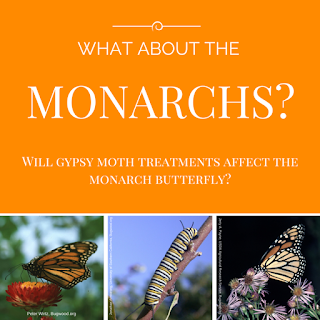Pest Program Outreach Coordinator
 As we’ve been conducting outreach and education about our proposed gypsy moth treatment plan, people are getting it: We need to treat for the gypsy moth to protect our environment. Btk is safe for people, pets, birds, fish, and bees. Btk only affects the caterpillars of moths and butterflies.
As we’ve been conducting outreach and education about our proposed gypsy moth treatment plan, people are getting it: We need to treat for the gypsy moth to protect our environment. Btk is safe for people, pets, birds, fish, and bees. Btk only affects the caterpillars of moths and butterflies.But if it affects these caterpillars, what does that mean for the monarch butterfly?
A great question indeed! The short answer (spoiler alert!) is that it doesn’t affect the monarch butterfly in our state. Keep reading if you would like to know why.
First, Washington is not a primary migration area for monarch butterflies; the primary migration path is in the Midwest. Eastern Washington has a handful of monarch sightings each year, but sightings are somewhat rare in Western Washington. (According to Learner.org, which tracks monarch sightings, only one adult monarch was sighted in Western Washington in mid-July in 2015. No eggs or larva were sighted. There were no monarchs sighted in Western Washington in 2014.)
In fact, compared to many other locations, butterflies of any kind are somewhat few and far between in Western Washington because they don’t much care for our wet weather.
 |
| Photo by Jim Occi, BugPics, Bugwood.org |
The monarch caterpillar (larva) begins feeding in our state in late June at the earliest. Gypsy moth treatments generally end in May. Because Btk degrades so rapidly, it would not affect any caterpillar beyond 10 days after treatment. Adult monarchs are not affected by Btk at all.
Both because of the low numbers of monarchs that migrate to Washington and because their lifecycle differs from the gypsy moth, WSDA’s gypsy moth treatments will not affect monarch populations. Visit agr.wa.gov/gypsymoth to learn more about the gypsy moth threat and WSDA’s work to protect our environment.
